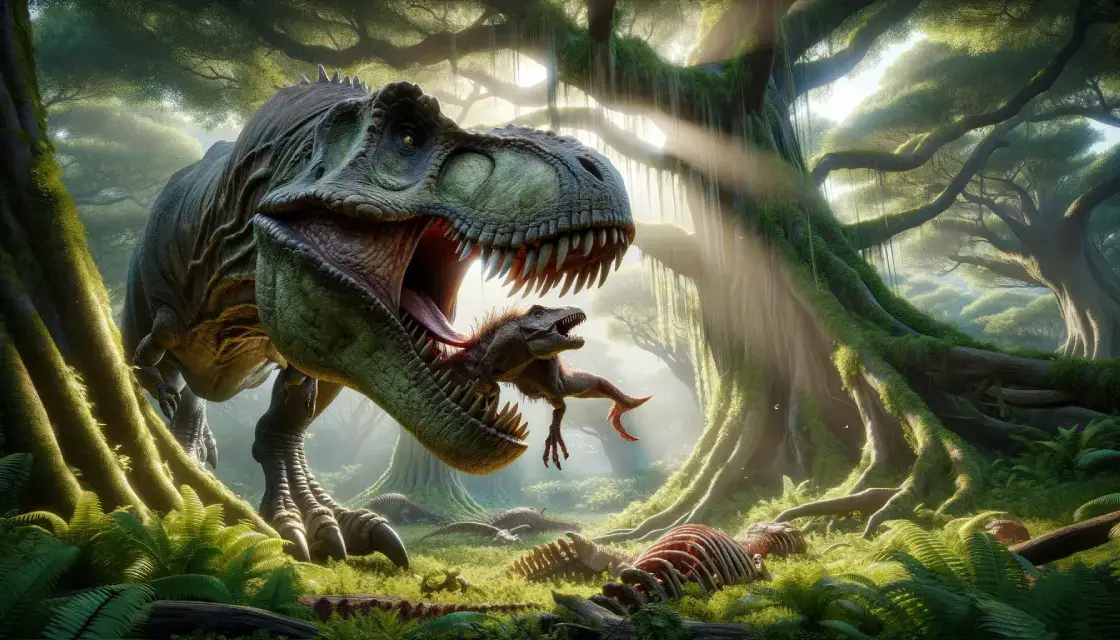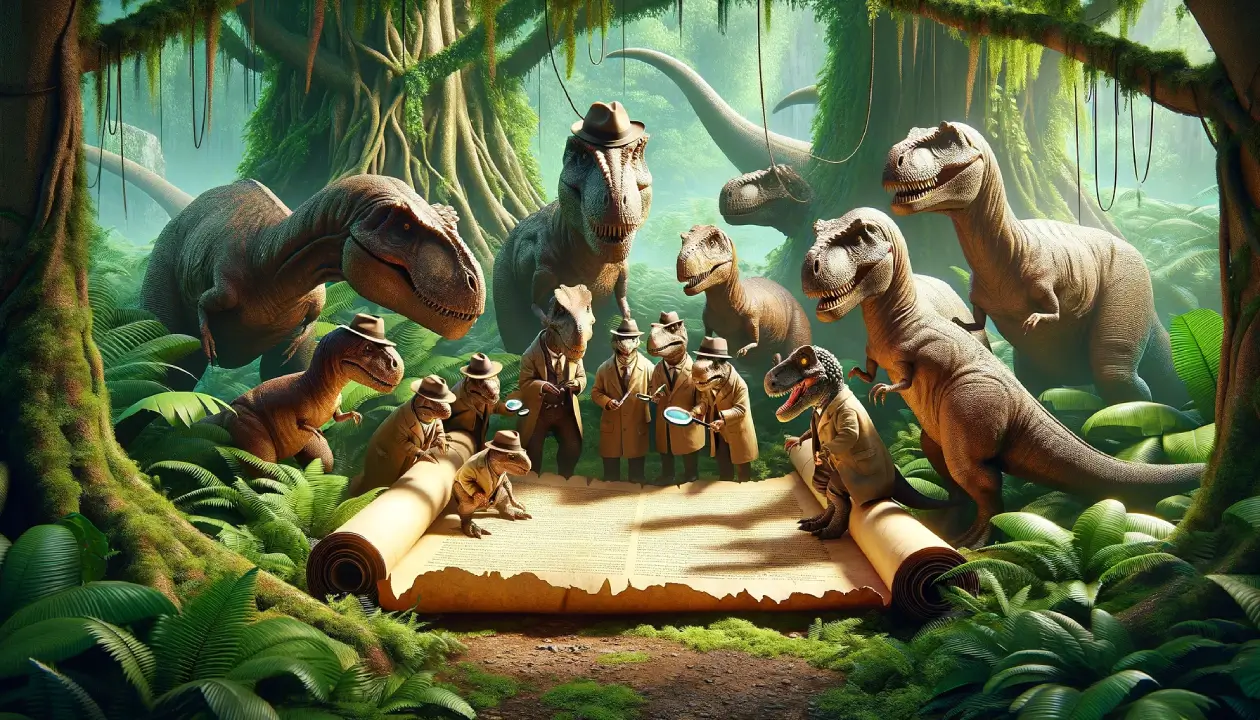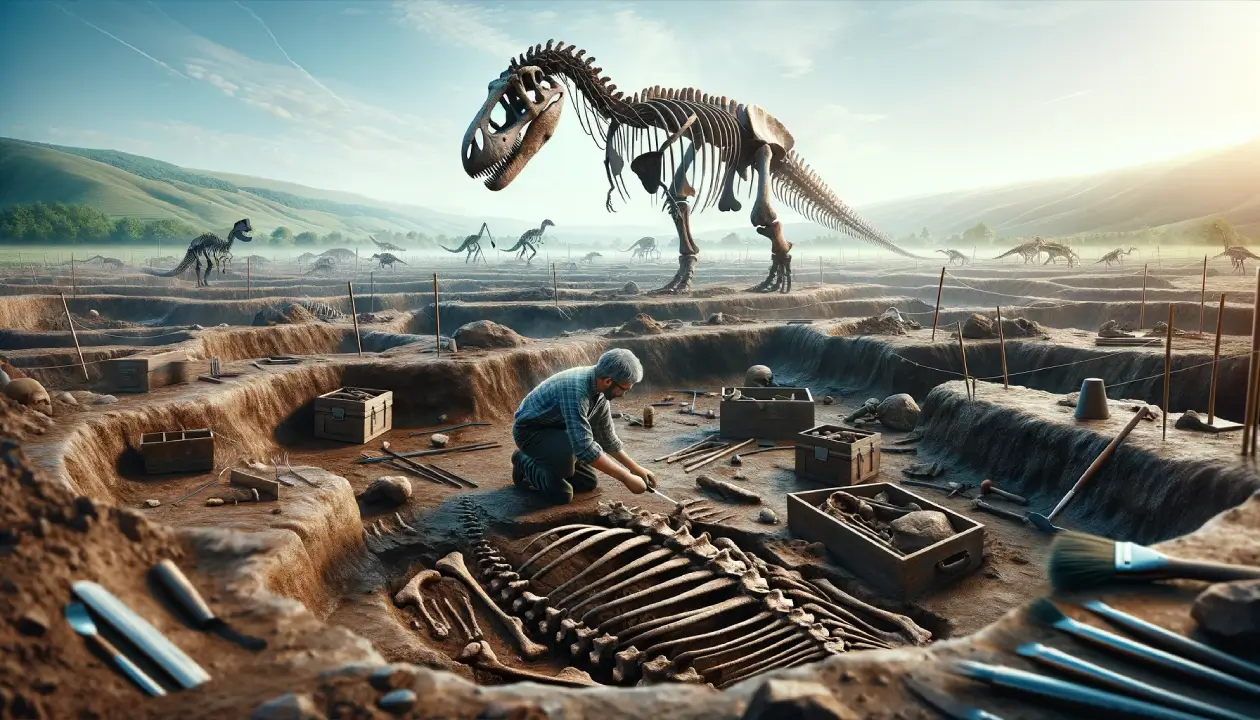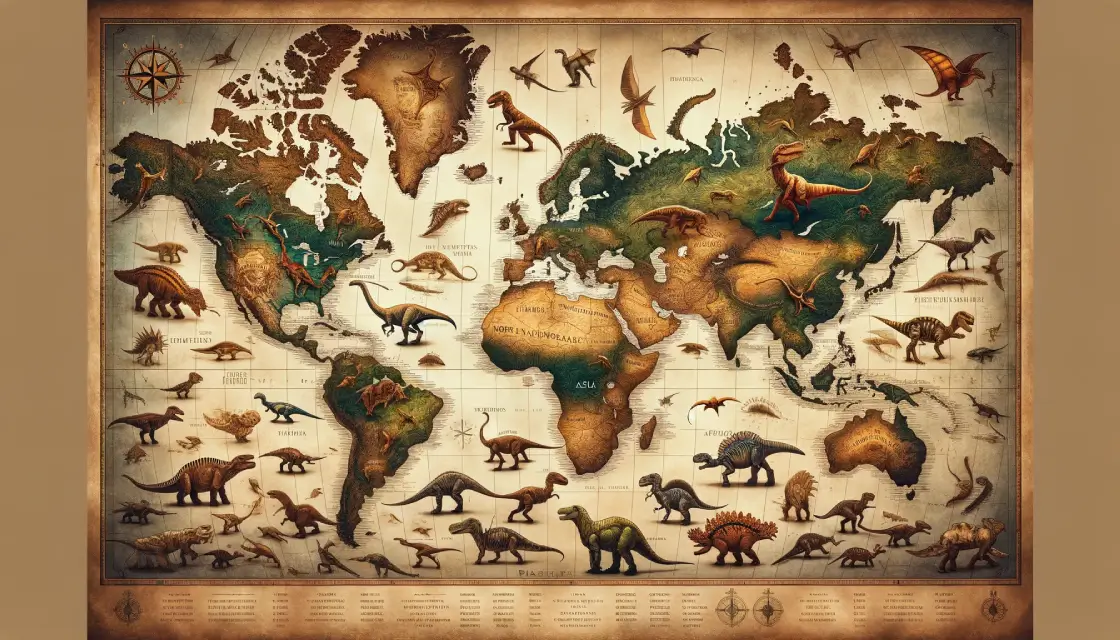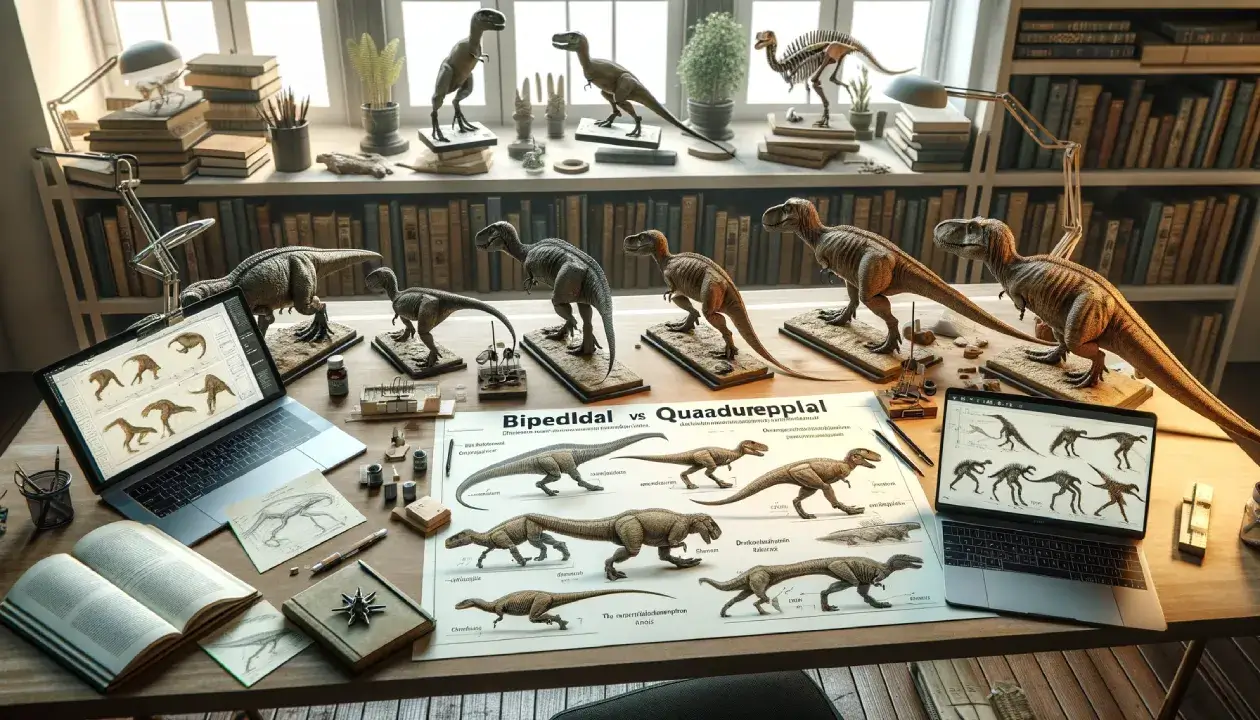Dinosaurs were a diverse group of reptiles that lived during the Mesozoic Era, between 252 and 66 million years ago. With over 1,000 identified species, dinosaurs came in all shapes and sizes and inhabited all continents. Their diets were as diverse as their forms. So what did dinosaurs eat? The short answer is that dinosaurs had diets including plants, meat, or both!
| Key Takeaways | Details |
|---|---|
| Dietary Diversity Among Dinosaurs | Dinosaurs had diverse diets categorized into carnivorous, herbivorous, and omnivorous groups. |
| Carnivorous Dinosaurs’ Prey | Large theropods like T. rex and Allosaurus preyed on other dinosaurs and scavenged for carrion. |
| Herbivores’ Plant-Based Diet | Massive sauropods like Apatosaurus fed on conifers and cycads, supporting their large sizes. |
| Adaptations to Diet | Dinosaur teeth and jaw structures were specialized for their specific diets (meat or plants). |
| Correlation Between Diet and Body Size | Plant-eating dinosaurs tended to grow larger than carnivorous ones due to abundant food sources. |
Dietary Diversity in Dinosaurs
Dinosaurs displayed a range of dietary preferences that can be categorized into 3 main types:
| Diet Type | Examples |
|---|---|
| Carnivorous | Tyrannosaurus rex, Allosaurus |
| Herbivorous | Apatosaurus, Triceratops |
| Omnivorous | Iguanodon, Kulindadromeus |
Carnivorous dinosaurs like the Tyrannosaurus rex and Allosaurus were large theropods or two-legged predators. Their diets consisted mainly of other dinosaurs, small vertebrates like lizards, and possibly carrion.
Massive long-necked sauropods like Apatosaurus and Brachiosaurus were herbivores that fed on conifers, cycads, and other Jurassic plants.
Omnivorous dinosaurs were able to consume both plant and animal matter depending on food availability. An example is the ornithopod dinosaur Iguanodon.
There were many types of dinosaurs roaming the planet, but these are the 3 main types of diets that dinosaurs ate.
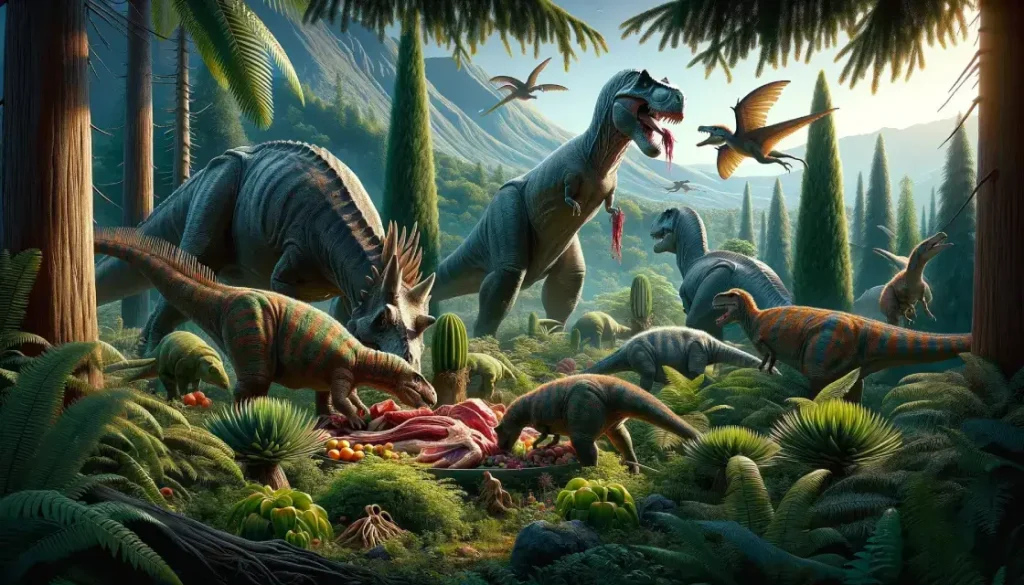
Carnivorous Dinosaurs
Meat-eating dinosaurs known as theropods include some of the most iconic and ferocious predatory dinosaurs like Tyrannosaurus rex and Allosaurus. These large bipedal dinosaurs used their saber-like teeth and muscular jaws to capture live prey.
| Carnivore | Prey |
|---|---|
| Tyrannosaurus rex | Hadrosaurs, ceratopsians |
| Allosaurus | Sauropods |
| Smaller theropods | Ornithopods, early mammals |
Tyrannosaurs likely hunted hadrosaurs and ceratopsians. Allosaurus probably targeted large sauropods. Smaller theropods hunted smaller ornithopods and early mammals. Pack hunting in some theropods is indicated by fossil evidence.
In addition to live prey, some theropods likely supplemented their diet by scavenging carcasses. Carrion provided an essential food source for these carnivores.
This provides an overview of the major dietary categories among dinosaurs. Their diverse forms and lifestyles were supported by a variety of plant and animal food sources during the Mesozoic Era. Understanding what dinosaurs ate gives us a window into the ecology and behaviors of these amazing prehistoric creatures.
Herbivorous Dinosaurs
Plant-eating dinosaurs known as herbivores included the giant sauropods. These four-legged dinosaurs like the Diplodocus and Brachiosaurus possessed long necks and massive bodies. Their diet consisted mainly of the primitive plants that covered the landscapes of the Mesozoic Era.
| Dinosaur | Dietary Plants |
|---|---|
| Sauropods | Cycads, conifers |
| Stegosaurs | Ferns, cycads, horsetails |
| Ankylosaurs | Ginkgos, seed ferns, bennettitales |
The sauropods fed on tough vegetation like cycads and conifers. Their peg-like teeth were well-suited for stripping leaves and branches. Other herbivores like stegosaurs and ankylosaurs also lived primarily on ferns, cycads, and horsetails.
Additional examples of Mesozoic plants that provided sustenance for dinosaur herbivores are ginkgos, seed ferns, and bennettitales. The abundance of these plants supported the massive sizes attained by plant-eating dinosaurs.
Omnivorous Dinosaurs
While most dinosaurs are classified as strictly herbivorous or carnivorous, some dinosaurs are considered omnivores. Omnivorous dinosaurs like Erlikosaurus and Kulindadromeus had diets that included both plant and animal matter.
Depending on food availability, these dinosaurs could adapt to consume vegetation or small vertebrates. Omnivory provided an evolutionary advantage in changing environments.
The Role of Teeth and Jaws in Diet
The morphology or shape of a dinosaur’s teeth and jaws provides clues about its dietary habits. Meat-eaters possessed knife-like serrated teeth for slicing flesh, while herbivores had surfaces better suited for grinding plant material.
For example, hadrosaurs like Edmontosaurus had over 1,000 teeth in batteries that enabled efficient processing of fibrous plants. In contrast, the jaws of Tyrannosaurus rex were optimized for delivering powerful crushing bites to kill prey.
To summarize, tooth and skull structures formed specialized adaptations that aligned with the diets and feeding behaviors of dinosaurs across all categories.
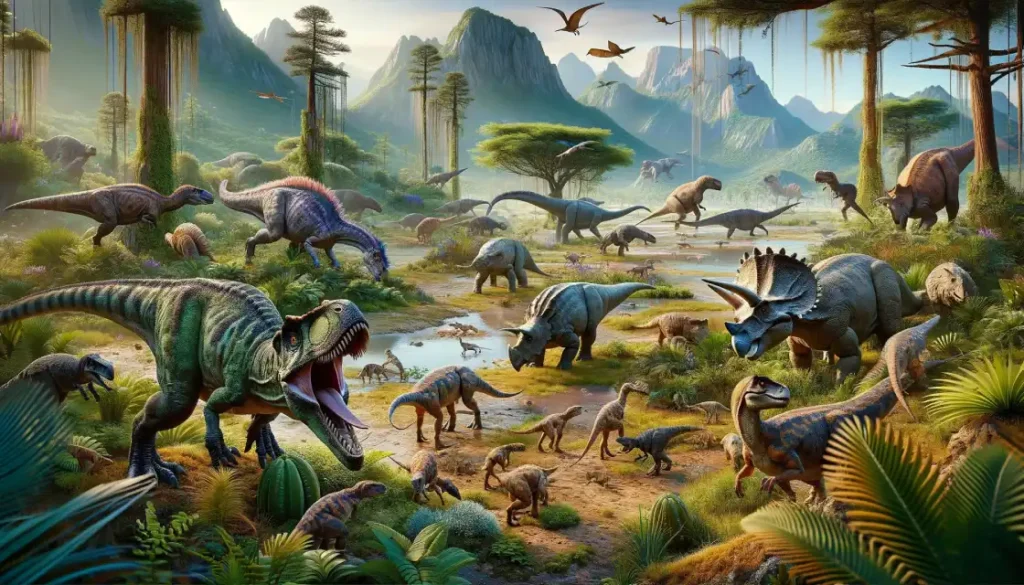
Diet and Dinosaur Size
The diet of dinosaurs had a direct correlation to their body size and mass. Herbivores that fed on abundant plant matter could attain much larger dimensions than carnivores.
The giant sauropods like Argentinosaurus reached lengths over 30 meters (98 feet) and weights up to 90 tonnes (100 tons). These massive herbivores consumed up to 182 kilograms (400 pounds) of food daily.
In contrast, the largest carnivorous theropods like Tyrannosaurus rex were smaller at 12 meters (40 feet) long and 9 tonnes (10 tons) in weight. Their meat-based diet limited their growth compared to herbivores.
Dinosaur Feeding Strategies
Different dinosaurs had unique feeding strategies based on their anatomy and behaviors as predators or herbivores:
| Dinosaur Type | Feeding Behaviors |
|---|---|
| Sauropods | Browsed on vegetation in herds |
| Theropods | Solitary ambush hunting |
| Armored dinosaurs | Cropped plants with beaks |
| Hadrosaurs | Ground plant material with 1,000 teeth |
| Velociraptors | Used claws and teeth to capture small prey |
Herding herbivores like sauropods traveled in groups while browsing on vegetation. Some may have employed social strategies like group defense against predators.
Large theropods were often solitary hunters that used their keen vision, speed, and jaws to ambush prey. Some theropods like Allosaurus possibly hunted in packs to take down massive sauropods.
Conclusion
In summary, dinosaurs displayed a remarkable diversity in their diets and feeding strategies. Meat-eaters, plant-eaters, and omnivores all adapted to obtain the food they needed from the prehistoric landscapes of the Mesozoic Era. Understanding dinosaur diets provides insight into their evolutionary adaptations, behaviors, and roles in ancient ecosystems.
If you want to know more about what dinosaurs were, what they looked like or where they lived you can check out our Dinosaur Basics.

